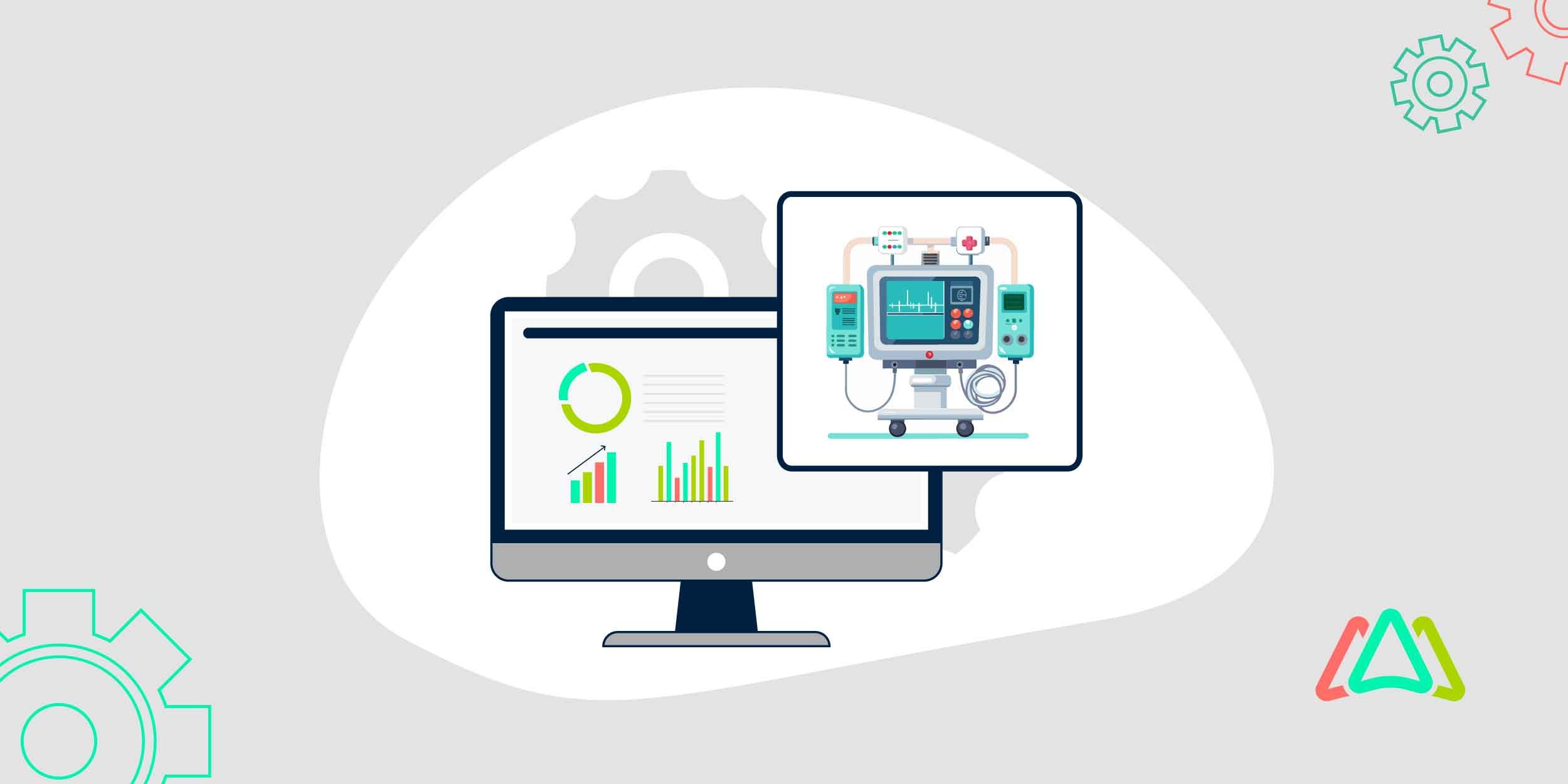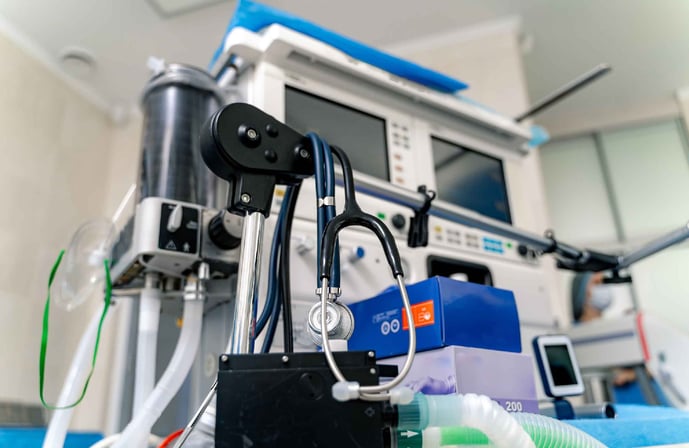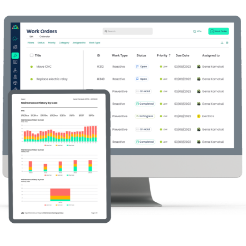
Understanding Medical Equipment Maintenance Management Software
In healthcare facilities, equipment uptime involves more than achieving operational efficiency—it’s about saving lives. Whether it’s MRI machines, ventilators, infusion pumps, or sterilization units, every piece of medical equipment plays a critical role in patient care. When one fails or doesn’t comply with regulations, the consequences can range from delayed treatment to patient safety risks. That’s why maintenance management has become a must-have technology for healthcare operations. For this reason, as facilities grow larger and technology becomes more advanced, keeping track of thousands of medical devices through manual logs or spreadsheets is no longer viable or safe.
This is where medical equipment maintenance management software comes into play. This specialized software—often built on a computerized maintenance management system (CMMS)—is designed to guide hospitals, clinics, and biomedical engineering teams in managing the full lifecycle of their medical assets. The specialized software automates maintenance scheduling, centralizes equipment data, ensures regulatory compliance, and supports data-driven decision-making. In doing so, it transforms reactive maintenance into a proactive, strategic process that promotes safety, reduces downtime, and controls costs.
This article explores what medical equipment maintenance management software is, why it’s essential in today’s healthcare landscape, and how it equips biomedical and clinical engineering teams to deliver consistent, high-quality patient care. We’ll also examine key features to look for in the software, common implementation challenges, and the future trends shaping this critical technology. This guide will help you understand how the right software can enhance your maintenance operations — from routine task management to a fully integrated, compliance-ready system.
The Challenge in Medical Equipment Maintenance
Managing medical equipment is far more complex than handling maintenance in most other industries. Healthcare facilities often rely on thousands of interconnected devices—everything from diagnostic imaging systems to patient monitors and surgical instruments. Each asset has a specific maintenance schedule, unique calibration requirements, and stringent regulatory documentation standards. The margin of error for downtime has to be next to none, given its potential to disrupt patient care, delay procedures, or compromise safety. As a result, biomedical and clinical engineering teams are under constant pressure to ensure every device remains operational, safe, and compliant while working within limited budgets and staff resources.
Traditional methods of managing medical equipment maintenance—such as manual logs, spreadsheets, or paper-based systems—fall short of meeting today’s demands. These outdated approaches make it difficult to track asset histories, identify failure patterns, or demonstrate compliance during audits. Time and efficiency are compromised when technicians have to struggle to locate accurate maintenance records or service histories. The result is missed inspections, duplicate work orders, and real clinical consequences when critical devices aren’t available when needed.
Regulatory compliance adds another layer of complexity. Healthcare organizations must meet strict standards set by governing bodies such as The Joint Commission (TJC), the U.S. Food and Drug Administration (FDA), and the Centers for Medicare & Medicaid Services (CMS). These agencies require meticulous documentation of preventive maintenance activities, calibration verification, and corrective actions. Failure to meet these standards can result in fines, accreditation risks, and reputational damage. Beyond compliance, there’s also the constant challenge of managing the total cost of ownership (TCO) for medical equipment—balancing repair costs, replacement planning, and warranty tracking across a vast and aging asset base.
In this challenging environment, healthcare providers increasingly recognize the need for a more systematic, technology-driven approach. Medical equipment maintenance management software has emerged as the solution to these pressures, offering a centralized platform to automate, monitor, and document every aspect of equipment upkeep. This robust and powerful software streamlines workflows, ensures data accuracy, and supports predictive maintenance strategies. In overcoming past maintenance deficits, the software helps biomedical teams shift from reactive firefighting to proactive asset management—an essential transformation for achieving both operational excellence and patient safety.

What Is Medical Equipment Maintenance Management Software?
Medical equipment maintenance management software is a specialized digital platform designed to streamline the upkeep, tracking, and performance monitoring of healthcare assets. It’s built on the principles of a CMMS but is tailored to the unique demands of medical environments. The software centralizes data for every device—its location, maintenance history, calibration schedule, and service records. It also automates preventive maintenance tasks, generates alerts for upcoming inspections, and stores documentation needed for compliance audits. Unlike other maintenance tools, medical equipment maintenance management software integrates with hospital systems and focuses on safety-critical features such as risk-based maintenance planning, device traceability, and regulatory reporting. Connecting technicians, equipment, and data on a single platform sets the stage for healthcare facilities to improve reliability, ensure patient safety, and meet regulatory standards more efficiently.
Core Features and Benefits of Medical Equipment Maintenance Management Software
The following core features illustrate how medical equipment maintenance management software delivers tangible benefits to biomedical teams and healthcare providers alike. (cmms for hospitals)
Asset Inventory & Equipment Registry
The software offers a comprehensive asset registry that serves as the backbone of maintenance management. It records vital details about each medical device, including make, model, serial number, location, and maintenance history. Having all this information in one place improves accountability, helps technicians quickly locate equipment, and enables data-driven planning. Hospitals gain complete visibility into their assets, reducing redundancy and allowing better resource allocation.
Preventive & Predictive Maintenance Scheduling
The software automates preventive maintenance schedules based on indicators such as manufacturer recommendations, usage data, or regulatory requirements. This ensures that routine inspections and calibrations are never missed. More advanced systems also incorporate predictive maintenance, using condition-based monitoring to detect potential failures before they occur. The result is fewer equipment breakdowns, longer asset lifespans, and a more reliable healthcare environment.
Work Order Management & Technician Workflow
Through an integrated work order system, biomedical technicians can easily create, assign, track, and close maintenance tasks. Mobile accessibility enables staff to update records in real time while on the floor or in the field. This process streamlines communication, improves response times, and eliminates duplicate or lost paperwork. In turn, it boosts productivity and ensures a consistent, well-documented maintenance process.
Compliance & Audit-Ready Reporting
Meeting strict healthcare compliance standards requires accurate, easily accessible maintenance documentation. Medical equipment maintenance management software automatically logs service activities, calibration results, and inspection records, creating a transparent audit trail. During regulatory reviews or internal audits, staff can quickly generate reports that demonstrate compliance with agencies such as The Joint Commission and the FDA—saving time and reducing stress.
Spare Parts & Inventory Management
Managing spare parts efficiently can make all the difference in a maintenance operation. This feature tracks part usage, stock levels, and reorder thresholds, linking each part to the equipment it supports. It helps reduce stock-outs and unnecessary purchases while ensuring technicians always have the parts they need to complete repairs quickly. Ultimately, this feature leads to cost savings and faster equipment turnaround times.
Analytics, KPIs & Decision Support
Data analytics dashboards provide healthcare administrators and maintenance managers with valuable insight into asset performance, downtime trends, and maintenance costs. By tracking KPIs such as mean time between failures (MTBF) or mean time to repair (MTTR), organizations can uncover inefficiencies and prioritize high-risk assets. These insights help guide budgets, forecast capital replacements, and continuously improve the overall maintenance strategy.

Key Considerations for Selecting and Implementing the Right Solution
Choosing the right medical equipment maintenance management software requires careful evaluation of both functionality and its fit within a healthcare organization’s existing infrastructure. The most effective solutions are designed specifically for medical environments, offering features like calibration tracking, regulatory reporting, and risk-based maintenance scheduling. Another key consideration is ease of use. Technicians should be able to quickly log work orders and access asset histories without extensive training. Integration capabilities are another factor to be considered. The software should seamlessly connect with hospital systems, such as EHRs (Electronic Health Records), ERP solutions, and procurement platforms, to enable seamless data exchange. For many facilities, cloud-based systems are often preferred for their scalability, remote accessibility, and lower IT overhead. On the other hand, some facilities may still opt for on-premises solutions depending on their data security policies and regulatory requirements.
A critical consideration is implementation because this is where many organizations face challenges. A successful rollout involves much more than installing software—it requires structured planning, accurate data migration, and effective change management. Before going live, facilities teams should ensure that existing asset data (including serial numbers, maintenance histories, and calibration schedules) is complete and standardized. Another key aspect of implementation is staff training, as it plays a role in user adoption. The bottom line is that if technicians and administrators don’t fully understand how to use the system, even the best software can underperform. In addition to comprehensive onboarding, starting with a pilot program in one department can help identify gaps before expanding to the facility-wide level. Clear communication, ongoing user support, and alignment among the biomedical engineering, IT, and compliance departments all contribute to a smoother transition and an effective implementation.
Once the implementation process is complete, measuring ROI and system effectiveness becomes an ongoing process. Facilities should track metrics such as reduced downtime, lower maintenance costs, improved compliance rates, and faster response times. Regularly reviewing these indicators helps justify the investment and fine-tune workflows as needed for continuous improvement. The ultimate goal is to ensure the software not only supports day-to-day operations but also contributes to long-term asset reliability, cost efficiency, and patient safety.
What Lies Ahead in Medical Equipment Maintenance Management Software?
Medical equipment maintenance management software continues to evolve alongside advancements in digital health and innovative technology. One of the most significant trends is the growing adoption of predictive maintenance powered by IoT (Internet of Things) sensors and real-time monitoring. By collecting data on equipment performance, temperature, vibration, and usage, these systems can detect early warning signs of failure and trigger maintenance before breakdowns occur. Artificial intelligence (AI) and machine learning are also becoming integral, helping healthcare organizations analyze large volumes of maintenance data to identify inefficiencies, predict repair needs, and optimize resource allocation.
Another key development is the expansion of cloud-based and mobile capabilities, which allow maintenance teams to access information, update work orders, and manage assets from any location. This flexibility in maintenance operations is especially valuable for multi-site healthcare networks and third-party service providers managing equipment across multiple facilities. Additionally, increasing regulatory scrutiny is driving a demand for more robust digital audit trails and automated compliance reporting, reducing the administrative burden on biomedical engineers.
Looking forward, integration will remain a dominant theme, linking maintenance systems with broader enterprise platforms such as hospital information systems (HIS), electronic health records (EHRs), and enterprise asset management (EAM) solutions. These integrations will create a consolidated view of operational performance, tying equipment reliability directly to patient outcomes and financial efficiency. As technology continues to advance, the role of maintenance software will move from a back-office management tool to a frontline facilitator of smarter, safer, and more sustainable healthcare delivery.
Conclusion
As healthcare organizations face increasing pressure to enhance patient safety, reduce costs, and meet strict compliance standards, medical equipment maintenance management software has become an indispensable part of their maintenance operations. This technology replaces fragmented, manual processes with a unified system that brings visibility, control, and accountability to every stage of equipment management. From tracking maintenance schedules and calibration records to automating compliance reporting, it enables hospitals and clinics to operate more efficiently and with greater confidence.
The benefits of medical equipment maintenance management software go beyond convenience—this software directly impacts healthcare outcomes. Equipment that is properly maintained and continuously monitored performs more reliably, minimizes downtime, and reduces the risk of treatment delays or patient harm. At the same time, data-driven insights help administrators make smarter purchasing and replacement decisions, ensuring that every maintenance dollar is spent effectively. The result is a safer, more cost-effective, and better-coordinated healthcare environment.
Ultimately, understanding and adopting medical equipment maintenance management software builds a foundation for quality care and long-term sustainability. As the healthcare industry continues to evolve, facilities that invest in these systems will be better positioned to adapt, remain compliant, and deliver consistent, high-quality patient care.
TABLE OF CONTENTS
Keep Reading
The longest U.S. federal government shutdown to date lasted 43 days, beginning on October 1, ...
5 Dec 2025
Every maintenance professional faces it sooner or later — that critical time when an aging ...
18 Nov 2025
The term 'best' is often used loosely, without a clear understanding of its context or ...
14 Nov 2025
In the not too distant past, maintenance strategies have been defined by reaction—fixing ...
13 Nov 2025
Tax season is the time of year that often sends a ripple of anxiety through many of us. The ...
11 Nov 2025
Selecting a Computerized Maintenance Management System (CMMS) can, at first glance, be an ...
4 Nov 2025
Companies are subject to economic ups and downs, also known as economic volatility. Today, ...
30 Oct 2025
Maintenance challenges are a constant struggle, with unplanned downtime costing manufacturers ...
27 Oct 2025
Last winter, a maintenance technician at a U.S. paper mill ignored a predictive alert that ...
10 Oct 2025
Many organizations proudly say they “have a CMMS,” but ownership alone doesn’t equal ...
9 Oct 2025
Every maintenance team is under pressure to do more with less. Unplanned downtime is often ...
7 Oct 2025
The implementation of simple, yet powerfully effective, checklists has repeatedly ...
3 Oct 2025
In manufacturing, every second counts. When production stops, whether due to scheduled ...
2 Oct 2025
The increasing cost of maintenance, lack of accountability, and siloed systems leave many ...
30 Sep 2025
Preventive maintenance is one of those things maintenance teams know they need to do, but it ...
26 Sep 2025
Public services are essential to daily life. The provision of safe roads, functional transit, ...
25 Sep 2025
For most manufacturing facilities, a major focus of their maintenance teams revolves around ...
24 Sep 2025
Have you ever tried explaining to the CEO why the production line has been down for hours ...
18 Sep 2025
Over the past few decades, the hotel industry has undergone a dramatic transformation. ...
16 Sep 2025
Profitability is at the top of the list for manufacturing organizations when conversations ...
12 Sep 2025





